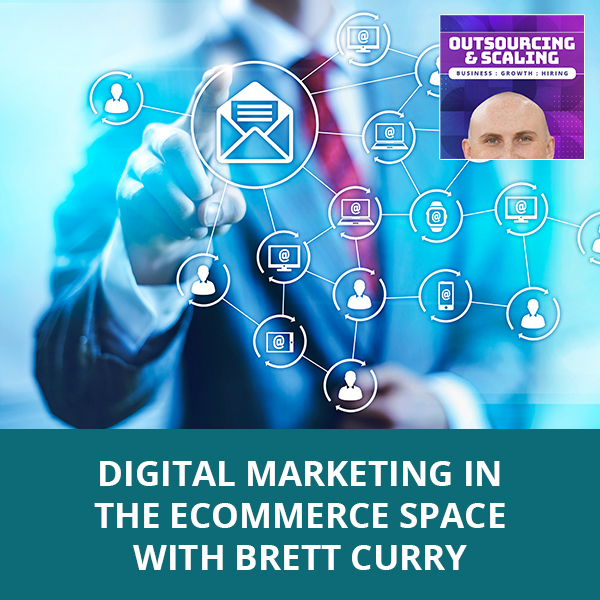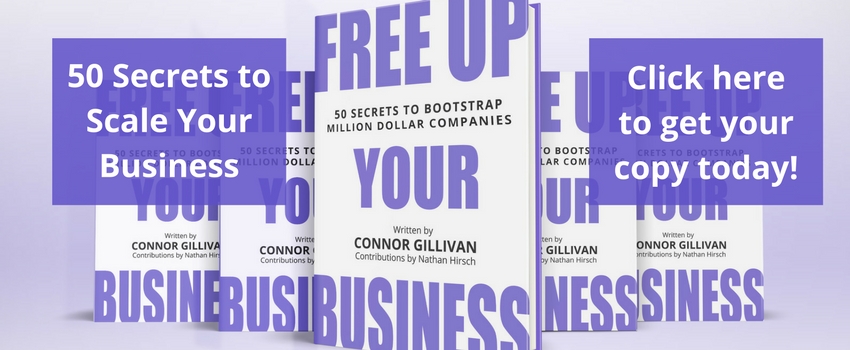


In this day and age, Google, Amazon, and YouTube still reign as kings in digital marketing. Someone whose insights on this area have helped over 100 growing brands, Brett Curry of OMG Commerce shares with us how bigger eCommerce sellers like these websites can drive businesses. He walks us through the process of building his agency and shares the way he structures it and hires the people for it. Brett also touches on leveraging Google, catching someone’s attention on YouTube, and selling on Amazon.
—
Listen to the podcast here:
[smart_track_player url=”https://www.podetize.com/statsapi/www.podetize.com/wp-content/uploads/fileuploads/11-5b145ef137b51b3d1af0633e9305c43d/10/2019/02c455a0d515916e30417d4cc3b5d10c.mp3″ title=”Digital Marketing In The eCommerce Space with Brett Curry” artist=”Nathan Hirsch” image=”https://freeup.net/wp-content/uploads/2019/04/OAS.png” ]
Download the audio file here.
Digital Marketing In The eCommerce Space with Brett Curry
My guest is Brett Curry. Brett, how are you doing?
I’m awesome, Nathan. How about you? Thanks for having me on.
I’m doing great. You are the CEO of OMG Commerce, the digital marketing agency and Google premium partner. You’re the author of The Ultimate Guide to Google Shopping published by Shopify. You’re also the host of the eCommerce Evolution podcast, highlighting what’s new and what’s next in eCommerce. You and your team managed Google, Amazon, YouTube and ad campaigns for over 100 growing brands. Your insights into Amazon and Google advertising have been featured on stage at top industry events like IRCE, Sellers Summit, Social Media Marketing World and more. His articles are featured on leading industry sites like Shopify, BigCommerce, Search Engine Journal and you’re a frequent guest on top marketing podcasts like eCommerceFuel, Perpetual Traffic, Social Media Examiner and many more. We’re going to focus the episode on bigger sellers, focusing on Google and YouTube and what they can do to drive business that way. First, I want to take a gigantic step back talking about what you’re like growing up. Were you a rebel? Were you’re straight-A student? Do you always know you wanted to be an entrepreneur?
I have appeared on a number of podcasts. I’ve only gone back to the childhood days on one other podcast. I always had a fascination with people and brands even as a kid. I was one of these inquisitive kids. I remember specifically asking my friends what their favorite brand of car was, because they’re all unique, but also like what their favorite brand of tire was and that weird stuff. I was interested in what people liked and what they wanted. I even got a fascination with ads fairly early. I remember I don’t know how old I was exactly when the Ginsu knife infomercials came out and you’d see the knife slicing through a Pepsi can and then slicing through a tomato. I was fascinated by that and I thought, “I wonder who creates those. That would be a cool gig.”
I was fascinated by marketing from the beginning. I’ve always been a little bit persuasive, stuff of my parents and stuff I have said so maybe selling was going to be in my nature. I didn’t experiment with too much along the entrepreneurial path. I didn’t have a paper route. I didn’t have a lemonade stand or other things like that that a lot of entrepreneurs did. I was fascinated in what makes people tick, why they buy things, why they like brands and then coupled that with my dad, who’s an awesome guy and super hard worker, not in sales or marketing. He’s always been in the construction equipment business but always encouraged me, “You can do whatever you want to do. You’ve got the capability.” I didn’t believe him at first, but I think he said it enough that it started to rub off on me a bit.
How did you first get into marketing and what was that like?
I was in college and a guy I knew from church worked at a radio station. I tried to sell him this MLM thing that somewhat roped me into and he was like, “I don’t want this, but you could be good at selling. Do you want to come work at the radio station?” We talked about it for a while like, “Yes, I do. Let’s do it.” I ended up putting myself through college working at a radio station selling airtime, selling radio ads and that’s where I realized I loved marketing. Some of those things were probably percolating since I was a kid and I was selling radio ads. I was coming up with radio ads for clients. I did a bit of on-air stuff because it’s a small radio station. It’s a ton of fun, but I quickly realized I loved marketing not much that I loved radio. Radio was cool. Radio always have a soft spot in my heart, but I just loved marketing and I switched my degree to marketing. I was working on a radio station during the day, going to school in the afternoon and decided then like, “I’d love to have my own agency one day.” That became the goal.
Talk to me about building your agency for the first time? What did that look like? How did you get that off the ground?
[bctt tweet=”One thing to get your freelancers or contractors motivated is by getting rid of negative people.” username=””]
It was not a traditional path. It was shortly after I graduated college. I’m 22 years old. My uncle who’s also a successful entrepreneur, he’s like, “I’ll help you get started,” not so much financial backing but helping with some things and we launched an agency. I was fresh out of college. I was working with all local type businesses. I got a used car dealer, a new car dealer and a handful of other clients right off the bat and a lot of that was because I built relationships around selling radio. It was people that trusted me and then thought that I am a hard worker and could take care of their ads and stuff. It’s what I did in the beginning. We started off great. When the economy hit rough times, I didn’t know what I was doing running an agency as a 22-year-old, so I hit some rough patches for sure. I got in the online marketing in 2004, started doing SEO for a client that wanted it and totally fell in love with SEO. That led to Google Ads and then I started Online Marketing Giant which became OMG Commerce in 2010. That’s when I started dabbling in Google Shopping and that’s when the light bulb came on, fell in love with that and from 2002 on is when we focused on eCommerce, specifically Google Ads, YouTube ads and then eventually Amazon for eCommerce.
Can you talk a bit about how you built the agency? Is it remote? Is it outsourced? Walk us through how you structured it.
In the beginning, it was definitely mix. When my business partner, Chris Brewer and I first started OMG, we thought maybe we’ll have one or two employees and then the rest will be out outsourced or just be us or one of those things. We had other businesses on the side when we started OMG, so we didn’t know, but we did hire a couple of people like admin-type folks. We outsourced technical things like the Google Ads management and also website design, website building which we quickly determined we didn’t like. I determined I hated it. It took us a couple years to unwind that and stop doing it, but that was all through freelancers. We were freelancing a lot of our Google Ads and stuff as well our outsourcing that.
We later shifted and realized if we’re going to be a real agency, we need to have contractors for some of the core functions. We started hiring and we have a team of about 30 contractors and a couple of freelancers. I still love the freelance model. Even if you go the route that we have where we’re primarily growing with contractors, there’s still some key roles that a freelancer can help with. As an example on the Google Ads side for our high-level Google Ads managers, the majority of those are contractors and we have a couple of skilled, good freelancers that don’t want to work direct with clients. They would rather work for an agency but they like the freelance model because it fits their lifestyle better so we have some freelancers there. There were some ups and downs just like with most things. Let me give to learn by experimenting and trying things.
This is more a testament to my team than it is to me, but we got the 2019 Inc. Best Places to Work award and we’re in the micro category. At the time we submitted it, we were about 25 contractors. We’re 30 now but we were one of the 300 companies in the nation to get it, one of only two in the state of Missouri, which is where we’re located. We’re super excited about that. We’ve worked hard to build this great culture, but several years ago, we would not have won that award. Things were still good, but we didn’t have to figure it out. Building culture, building proper lines of communication within teams, getting of the right hiring process all of that, a lot was trial by fire. We’ve got that dialed in now. We’re good on the hiring process. Once we get someone in, we have a lot of fun doing what we’re doing. We communicate well as a team. We hold people to high standards and usually we’re able to weed out the people that don’t fit relatively quickly, happy to dive in any specifics there too.
A lot of people that come from agencies, they left the agency because they were super stressed out. It was a bad culture and they wanted to get out of that as fast as possible. What have you done? What would you tell an agency owner that’s reading this? Let’s say they have a hybrid of in-person, remote freelancers, virtual assistants and they’re struggling to keep people motivated, to have a good culture, what advice would you give?
One of the first things you have to do is you have to get rid of negative people, whether it’s a freelancer or a contractor. If they are a drain, if you’ve heard one or multiple people say, “We got to think about getting rid of this person because they’re just a drag,” I think by the time that gets to the owner, you’ve got a real problem. Usually, I’ve done this myself because I believe in people. I want to believe the best. I want to get people saying chances, but there are some things where you realize that this person’s probably not going to change and they’re a drag. They’re wind drag on the whole company so we got to get rid of negative people. That’s the first thing that then becomes a real morale booster and that’s positive impacts on the rest of the team knowing that the leadership, the owner of the company is going to take action if someone is detrimental to the culture of the company.
You have to then fight for good culture. You have to say, “These are the things we believe,” even map out your culture statement. We believe in having fun solving difficult problems. We believe in helping each other level up. We believe in owning our stuff, good and bad. There are some more actual cultures statements. We talk about this in the interview process if someone kind of squirms or they’d simply they don’t light up as we say those. We know that probably they’re not a great either freelancer or contractor if they don’t line up with those culture values and then we preach. We have to give a good feedback. You’re going to get feedback from leadership. We encourage feedback amongst the team.

We have difficult conversations. If we ever lose a client, we have maybe a morbid description, we have autopsy meetings like, “What could we have done better?” It’s one of those meetings where we challenge people. If someone on the team is trying to sidestep it or be too nice to us, don’t accept that, “I think we dropped the ball on this thing and that fractured the relationship.” We try to tough conversations as well. That’s a highlight of at least a few things. It’s getting the right people, getting rid of negative people, having honest conversations, then just reminding over and over again who we are as a culture, what are we pushing towards and measuring some of those things as best as you can.
We’re in a stage where so many people are always looking for leads. There are so many leads you can market. You could be looking for more clients but the good agencies they’re looking on retention are saying, “These clients we have, how can we keep them?” If they are slipping through the cracks, that’s a problem and we need to fix that problem. There’s always going to be stuff you can’t control, someone who have business issues whatever it is but focusing out, you can control it. How you can prove that is so important?
We had an experience where I like this individual, but we let a client go because it wasn’t a good fit. My team was super frustrated and they seemed pressured. It wasn’t a fit for a variety of reasons that I won’t go into. Sometimes stuff like that happens but you were right if you’re losing clients and there’s something broken in with your processes or with your team. Fix that first because it’s so expensive to go out and get either time or money. It’s so expensive to go out and get new clients just to lose them because your processes aren’t shored up. We get the wrong people doing the wrong things. You’ve got to fix those issues first for sure.
Let’s talk about big eCommerce sellers. They’re doing a lot. They’re crushing Amazon PPC and maybe they’re running some Facebook ads. They have not tapped into Google. They haven’t tapped into YouTube. Why should they?
There are a couple of things to consider before you look at how do we leverage and how do we use Google. There are some products that are more awareness based meaning they’re products that solve a real problem. They’re the solution to a real problem. The interesting people want them but people maybe don’t know they want them, so they need to be made aware of the product. They need some interruption advertising whether that’s Facebook or an email from affiliate emails, something like that saying, “Check out this new cool product.” There are other products that lend themselves well to search, meaning I know these products exist. I’m not going to buy them until I have a need. What examples I use a lot is auto parts. If I were a DIYer with my car, which I’m not, I take it places but needed brake pads, I’d go to either Amazon or Google search for brake pads. Seeing an ad on Facebook talking about how awesome this seller is with their brake pads is not going to move me because I haven’t need them so I’m going to go search for it.
For the most part, people that are successful on Amazon, if you have your own website, you’ll be successful with Google Ads too because Amazon is a search play. That’s how people discover products on Amazon. If it does well with Amazon search, it’s going to do well with Google Search. Most likely as well if your site is good. There are still billions of searches done every day on Google. It is true that more product searches begin on Amazon and begin on Google, but you got those two. If I’m going to buy a new product, I need a new short sleeve dress shirt, I’m either going to go to Amazon or I’m going to go to Google to search for that product. If you’re crushing it on Amazon with a product, you can likely do great with Google search and Google Shopping.
I recommend starting with the basics of starting with Search and Shopping first or if you’re new to Google traffic, start with those two. Start with what we would call bottom or funnel traffic. Start with people that are either searching for your brand or searching for your exact product. Start with people that are closest to making a purchase, not someone who’s maybe in the early stages of research. The reason I say that is because it can be expensive if you’re going higher in the funnel. Reaching people that are maybe just beginning to research Home Décor, they’re not ready to buy. Go get them later. If you have a client that sells picture frames and bedding and things like that, maybe start with people searching for 9×7 custom wood frames. That keyword, that level of specificity, focus there first and then you can start to go up.
Maybe target people that are just looking for wood picture frames. What we recommend is if you get some data on Amazon, what’s working on Amazon for those same keywords are probably going to work on Google as well but Google Search and Shopping are a great place to start and then you can start in remarketing. The other piece is look at Google display remarketing, YouTube remarketing. Once you get those dialed in, then you can look higher in the funnel which would be more like generic search, broader search keywords and then maybe even YouTube to cold traffic as a potential.
[bctt tweet=”Google is consistently an effective channel for most eCommerce stores. ” username=””]
YouTube, you only pay if you get past that 30-second mark on the ad. How does the average eCommerce seller catch someone’s attention in that first five second? Because if someone’s going to YouTube, they’re going to YouTube to watch that video not to watch the ad. I know me personally, I skip through those ads 99.9% of the time. How do you capture that attention to make them watch that 30 seconds?
It’s so critical and you alluded to it. As an advertiser, you only pay if someone engages with the videos so someone has to watch to the 30-second point if the video is longer than 30 seconds or they have to watch the whole video if it’s less than 30 seconds or they have to click through to your site. Engage with it before you get an advertiser charge, which is great. In your case, some people that are like you which is most people, they see an ad and they’re already skipping. You don’t pay for those which is great. The first five seconds are key. It’s best with the first videos you’re creating, be direct and be to the point. Let someone see right away what this product is, what it does, who it’s for so that you get people that are not interested to skip. You don’t pay for that and people that are interested will keep watching.
Sometimes if you’re watching a Super Bowl ad or something, the first 18 seconds of the 30-second commercial’s all humor and it’s the build-up of the story. You don’t know where it’s going, but you’re watching because it’s a Super Bowl ad and it’s fun or funny and then at the end, there’s the reveal for it’s a new cologne or it’s the new Budweiser commercial. That works in that environment because you paid for that spot. You better get as many people watching that as you possibly can. It’s just purely a branding play. With YouTube, you run the risk if you go that route of getting the wrong people to watch because they’re bored or you capture them. You made them laugh so they’re watching and maybe the right people are skipping because they don’t have the patience. I like to lead with, “Here’s what this is, what it does, who it’s for.” Lead with the strongest benefit. Leading with, “Are you tired of waking up stiff and sore and cranky? It’s probably not what you think, it’s probably what you’re sleeping on,” or something like that.
Starting with a direct approach. There are a number of things you can do in the first five seconds, things like having movement, having some kind of an eye grabber. There are lots of things you can do. The first videos you test though are more of a direct test of, “Have you seen this product? Have you seen this thing? Have you heard the buzz about this product? Here’s why so many people love it.” The direct approach is the most powerful. There are things you can do. I’m sure you’ve seen the Poo-Pourri video where it’s got the little petite British actress sitting on a public toilet in the dress and she talks about what she just did. It’s one of those shocking, but funny and I got to watch this, but at least it addresses the problem immediately. This is about something bathroom related and it’s funny, but you get hooked that way.
That’s a few of the things that I like to do direct lead with the strongest benefit, make it clear either what the product is or what the problem is that you’re solving, so that you attract the right person and keep them around and then you go from there. Those first five seconds are critical and the way I view it is frame it in such a way that people that are not interested, they skip because you don’t need to pay for them and you don’t want people that aren’t interested to watch because you’re wasting your money there.
Talk to me about Google because I feel like a lot of people are getting away from Google Ads for whatever reason. I love your take on it. Why should people still be going to Google?
It’s consistently effective channel for most eCommerce stores. One of the things we run into, and I don’t know and run any Facebook ads myself, but in all the masterminds and communities I’m in and stuff like that, our clients or most of them are running Facebook ads. Facebook ads have increased in price to the tune of maybe about 30% a year. It depends on how engaging your ads are and things like that on what I should pay for it, but Facebook prices are going up. For Google, if you look at Google Search and Google Shopping, it’s a much more mature platform and it’s self-regulated. It’s auction-based. For most eCommerce companies, if I’m selling sneakers or I’m selling men’s dress shirts or I’m selling handbags or whatever, those bids are going to be regulated by the market. There aren’t going to be other sellers willing to pay $10 for a click for a backpack.
No one’s going to make money on that. It’s fairly self-regulated. What I think the prices about, everything is going up, the prices, the CPC’s on Search and Shopping, remaining fairly stable and that’s probably going to continue. Prices on YouTube are potentially going up, but if you do it the right way, it can be very effective still. It’s a mature platform. It works. The prices are a little more consistent and then I’m a big believer in you have to diversify your traffic sources. If you’re one of those brands we meet them all the time that was built on Facebook, great. Keep leveraging Facebook, leverage Instagram. Probably Instagram is going to be working well for you. It works, it’s effective and it helps you diversify your traffic, which is something that every eCommerce store needs. It’s also measurable because I think most of your audience is selling on Amazon too.

We’ve diversified a lot. We started off in Amazon and work with a ton of marketing agencies. That spreads into different online businesses but a good majority of them are eCommerce and the core of eCommerce is Amazon.
if you’re selling on Amazon, you’ve got your Amazon sponsored products, your sponsor brands are dialed in. You know what keywords are working and things like that. That data is going to translate well to Google. You can leverage that success you’re having on Amazon and recreate that on Google. What we’ve found because we run a ton of Amazon ads and Amazon department that’s been growing over the last several years, CPC’s are in a lot of categories lower on Google than they are on Amazon. The difference is your conversion rate is usually lower on your website than it is on Amazon. It balances out a little more, but your CPC, your Cost Per Click on Google, is likely going to be less than what you’re paying on Amazon.
Brett, anything else that you want to share to our audience, especially the bigger sellers when doing Google or YouTube?
When it comes to YouTube, there are a couple of things I would recommend. It is a phenomenal channel, I’m bullish on YouTube, but if you look at usage statistics and the way people are consuming the channel usage, it’s growing in every category. I saw a report on Millennials and Gen Z that the three fastest social media platforms are YouTube, Snapchat and Instagram. I’ve got kids that are in Gen Z, none of them are interested in Facebook. They’re all interested in Instagram, but all of them use YouTube. Even older demos are using YouTube so it’s the place people go to research, to learn what to buy, how to fix things all that. It’s a phenomenal channel and some of the new ad formats allow you to bid to try to get conversion. It’s now a great direct response platform, but I would still recommend if you’re starting on YouTube to start with remarketing.
We talked about how important that first five seconds is to hook someone. I still recommend you start with remarketing. If you’re going to dabble in YouTube ads, run retargeting or remarketing with YouTube first. Run those to your cart abandoners, to your prior detailed page visitors that have not converted. Run YouTube there first and make sure it works. Make sure you get the right pitch and the right appeal and because if you run an ad to that group and they don’t buy, it’s not going to work to cold traffic either. That’s a great place to test. Start with remarketing as that is working and getting more dialed in then expand. Go higher in the funnel and look at targeting cold traffic. The way I would look at it is get your Google Search, Shopping and remarketing dialed in first and then start to move higher in the funnel, but start low and go high in the funnel. That usually works best.
Where can people find out more about you and what are you most excited about?
Things I’m most excited about is continuing to geek out on YouTube and there’s some new ad formats, some new betas that are coming out there. There are some new things that are coming with Google Shopping that I’m excited about, a blend of Google Express. It’s where you can buy without ever leaving Google, blending of that in Google Shopping which is coming. It’s all Google trying to compete with Amazon and trying to make Google as much of a destination to shop for products as Amazon is. I’m excited about some new things with Google Shopping. To connect in the short term, OMGCommerce.com. It’s the best place to check us out and find details on what we do and how to contact me there. Also, happy to connect on LinkedIn or Facebook. I’d love to connect and thanks again for having me on.
Thanks for being here. Have a good rest of the week.
Thanks, Nathan.
I appreciate it.
Important Links:
- OMG Commerce
- The Ultimate Guide to Google Shopping
- eCommerce Evolution
- OMGCommerce.com
- LinkedIn – Brett Curry
- Facebook – Brett Curry
About Brett Curry
 Brett Curry is the CEO of OMG Commerce, a digital marketing agency and Google Premier Partner. Brett is the author of The Ultimate Guide to Google Shopping published by Shopify. He is also the host of the eCommerce Evolution Podcast highlighting what’s new and what’s next in eCommerce. He and his team manage Google, Amazon, and YouTube ad campaigns for over 100 growing brands. His insights into Amazon and Google Advertising have been featured on stage at top industry events like IRCE, Seller Summit, and Social Media Marketing World. His articles are featured on leading industry sites like Shopify, Big Commerce, and Search Engine Journal, and he’s a frequent guest on top marketing podcasts like Ecommerce Fuel, Perpetual Traffic, Social Media Examiner and many more.
Brett Curry is the CEO of OMG Commerce, a digital marketing agency and Google Premier Partner. Brett is the author of The Ultimate Guide to Google Shopping published by Shopify. He is also the host of the eCommerce Evolution Podcast highlighting what’s new and what’s next in eCommerce. He and his team manage Google, Amazon, and YouTube ad campaigns for over 100 growing brands. His insights into Amazon and Google Advertising have been featured on stage at top industry events like IRCE, Seller Summit, and Social Media Marketing World. His articles are featured on leading industry sites like Shopify, Big Commerce, and Search Engine Journal, and he’s a frequent guest on top marketing podcasts like Ecommerce Fuel, Perpetual Traffic, Social Media Examiner and many more.

